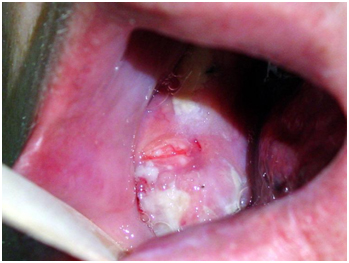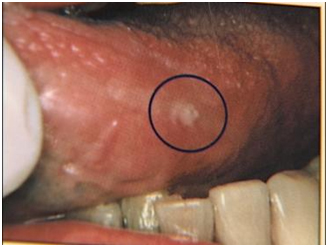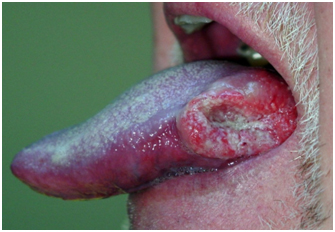Understanding Cancer
Cancer begins in cells, the building blocks that make up tissues. Tissues make up the organs of the body. Normally, cells grow and divide to form new cells as the body needs them. When cells grow old, they die, and new cells take their place.
Sometimes this orderly process goes wrong. New cells form when the body does not need them, and old cells do not die when they should. These extra cells can form a mass of tissue called a growth or tumor.
Oral Cancer is part of a group of cancers called head and neck cancers. Most oral cancers begin in the tongue and in the floor of the mouth. Almost all oral cancers begin in the flat cells (squamous cells) that cover the surfaces of the mouth, tongue, and lips. These cancers are called squamous cell carcinomas.
What Are the Symptoms of Oral Cancer?
The most common symptoms of oral cancer include:
- Swellings/thickenings, lumps or bumps, rough spots/crusts/or eroded areas on the lips, gums, or other areas inside the mouth.
- The development of velvety white, red, or speckled (white and red) patches in the mouth.
- Unexplained bleeding in the mouth or mouth sores.
- Unexplained numbness , loss of feeling or pain /tenderness in any area of the face, mouth, or neck.
- Jaw stiffness , Difficulty chewing or swallowing, speaking, or moving the jaw or tongue. Hoarseness, chronic sore throat , or change in voice.
- Earache or Ear pain
- A change in the way your teeth or dentures fit together.
- Dramatic weight loss .
- Persistent sores on the face, neck, or mouth that bleed easily and do not heal within 2 weeks.
- A soreness or feeling that something is caught in the back of the throat.
If you notice any of these changes, contact your dentist or health care professional immediately.
Early signs of oral cancer
- LEUKOPLAKIA (WHITE PATCH) : A white painless patch, mostly on the buccal mucosa or any place in the mouth, is a precursor of oral cancer, and can be easily observed and diagnosed by a dentist or surgeon.
- ERYTHROPLAKIA (RED PATCH) : A red patch, it is sometimes associated with leukoplakia, and occurs without trauma or pain. It has a high probability of growing into malignancy.
- SUBMUCOSAL FIBROSIS : A typical condition seen in South Asia, it involves fibrosis of oral mucosa, with difficulty in opening of mouth. This is usually associated with areca chewing or tobacco use.
Who Gets Oral Cancer?
According to the American Cancer Society, men face twice the risk of developing oral cancer as women, and men who are over age 50 face the greatest risk. It's estimated that over 35,000 people in the U.S. received a diagnosis of oral cancer in 2008.
Risk factors for the development of oral cancer include:
- Smoking , Cigarette, cigar, or pipe smokers are six times more likely than nonsmokers to develop oral cancers.
- Smokeless tobacco users. Users of dip, snuff, or chewing tobacco products are 50 times more likely to develop cancers of the cheek, gums, and lining of the lips.
- Excessive consumption of alcohol. Oral cancers are about six times more common in drinkers than in nondrinkers.
- Family history of cancer.
- Excessive sun exposure, especially at a young age.
It is important to note that over 25% of all oral cancers occur in people who do not smoke and who only drink alcohol occasionally.
In early stages, oral cancer is usually not very symptomatic , and whatever complaints are there, may be easily overlooked resulting in loss of precious time and with it an opportunity to remove the lesion. Thus it is very important to know the forms in which oral cancer may occur and the symptoms that it may produce.
Methods of diagnosis:
Clinical examination: The emphasis for the dentist should be on an oral examination of each patient rather than a dental examination.
Biopsy: No treatment of lesion should proceed before histologist confirmation of the lesion's malignancy is available. This allows him to assess the lesion before any surgical mutilation.
Fine needle aspiration: Fine needle aspiration cytology has found an increasing role in the diagnosis of head and neck malignancy.
Clinical staging: The staging of malignant disease can be accomplished by various systems. The most valuable of these provide some indication of the prognosis for the patient and can be used as a guide to appropriate treatment.
Treatment of Oral Cancer
After a definitive diagnosis has been made and the cancer has been staged, treatment may begin. Treatment of oral cancers is ideally a multidisciplinary approach involving the efforts of surgeons, radiation oncologists, chemotherapy oncologists, dental practitioners, nutritionists, and rehabilitation and restorative specialists. The actual curative treatment modalities are usually surgery and radiation, with chemotherapy added to decrease the possibility of metastasis, to sensitize the malignant cells to radiation, or for those patients who have confirmed distant metastasis of the disease.
Surgical treatment retains its prominence as the principal means of achieving the cure of an oral squamous cell carcinoma . Surgical treatment has two distinctive phases, the resection of the tumor and the reconstruction of the defect. Reconstruction may be immediate or delayed.
Management of a patient after Oral Cancer Treatment
Whether a patient has surgery, radiation and surgery or radiation, surgery and chemotherapy, all is dependent on the stage of development of the cancer. Each case is individual.
Patients with cancers treated in their early stages, may have little in the way of post treatment disfigurement. For those whose cancer is caught at a later stage, the results of surgical removal of the disease may require
reconstruction of jaws, portions of their oral cavity or facial features.
There may be adjunctive therapy required to assist in speech, chewing of foods, the problems associated with the lack of salivary function, as well as the fabrication of dental or Maxillo-facial prostheses.
Make an appointment with your dentist if you have any persistent signs and symptoms that bother you and last more than two weeks. Your dentist will likely investigate other more common causes for your signs and symptoms.
Your regular checkup is a good time for your dentist to check your entire mouth for signs of cancer. Regular checkups can detect the early stages of oral cancer or conditions that may lead to oral cancer.







